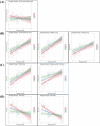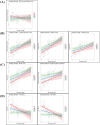Handgrip strength in elite youth football: potential for performance prediction and the moderating effects of age and maturation
- PMID: 40697532
- PMCID: PMC12279509
- DOI: 10.3389/fspor.2025.1625015
Handgrip strength in elite youth football: potential for performance prediction and the moderating effects of age and maturation
Abstract
Handgrip strength (HGS) is a simple and reliable indicator of general muscular strength, yet its relevance in elite youth football remains insufficiently understood. This study examined the utility of HGS as a practical indicator of athletic performance in this population, focusing on its associations with sport-specific motor abilities and the moderating influence of age and biological maturation. A total of 221 elite male youth football players aged 11-19 years completed a standardized performance test battery that included HGS (via dynamometer), dynamic balance (Star Excursion Balance Test), vertical jumps (Counter Movement Jump, Abalakov Jump, Heading Jump), horizontal jumps (Broad Jump, Single-Leg Hop for Distance), and sprints (10 m and 30 m). Pearson correlation coefficients were used to assess associations between HGS and motor performance outcomes, while linear regression models tested the moderating effects of age and maturity offset. HGS was strongly associated with jumping (r = 0.69-0.75 for vertical; r = 0.73-0.75 for horizontal) and sprinting performance (r = -0.62 to -0.73) and showed small but significant associations with dynamic balance (r = -0.29; all p < .001). Regression analyses confirmed significant main effects of HGS on jumping (β = 0.31-0.60) and sprinting (β = -0.23 to -0.33), moderated by both age and maturation status. No significant effects were observed for balance. The combination of HGS and age accounted for up to 67% of the variance in sprinting and up to 61% in jumping. These findings demonstrate that HGS is a robust and practical predictor of sprinting and jumping performance, especially when combined with age. This makes HGS a valuable, resource-efficient tool for performance diagnostics and talent development in elite and youth football, especially in settings where extensive testing is impractical.
Keywords: biological maturation; functional testing; hand grip dynamometer; lower limb power; performance testing; sprint speed; youth athletes.
© 2025 Schulz, Wizani, Matits, Schwarz, Wiedemann, Bizjak, Jerg, Kirsten and Henze.
Conflict of interest statement
The authors declare that the research was conducted in the absence of any commercial or financial relationships that could be construed as a potential conflict of interest.
Figures


Similar articles
-
Unresisted Sprints Versus Heavy Resisted Sled Training: Relationships With Performance Indicators and Implications for Training Prescription in Elite Youth Rugby Players.J Strength Cond Res. 2025 Jul 9;39(9):989-995. doi: 10.1519/JSC.0000000000005215. J Strength Cond Res. 2025. PMID: 40644672
-
Electromyostimulation--a systematic review of the effects of different electromyostimulation methods on selected strength parameters in trained and elite athletes.J Strength Cond Res. 2012 Sep;26(9):2600-14. doi: 10.1519/JSC.0b013e31823f2cd1. J Strength Cond Res. 2012. PMID: 22067247
-
Associations Between Measures of Balance and Lower-Extremity Muscle Strength/Power in Healthy Individuals Across the Lifespan: A Systematic Review and Meta-Analysis.Sports Med. 2015 Dec;45(12):1671-92. doi: 10.1007/s40279-015-0390-z. Sports Med. 2015. PMID: 26412212 Free PMC article.
-
Effects of a Short-Term Ballistic Training Program on Performance and Strength Deficit in Elite Youth Female Soccer Players.Sports (Basel). 2025 Jul 21;13(7):237. doi: 10.3390/sports13070237. Sports (Basel). 2025. PMID: 40711122 Free PMC article.
-
Physical exercise training interventions for children and young adults during and after treatment for childhood cancer.Cochrane Database Syst Rev. 2016 Mar 31;3(3):CD008796. doi: 10.1002/14651858.CD008796.pub3. Cochrane Database Syst Rev. 2016. PMID: 27030386 Free PMC article.
References
LinkOut - more resources
Full Text Sources

